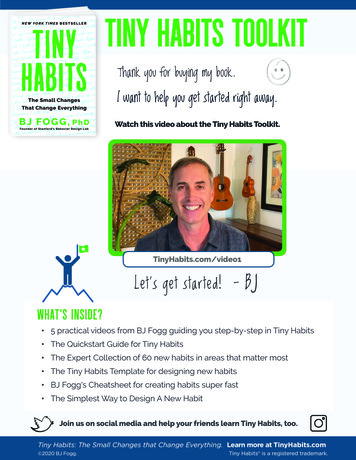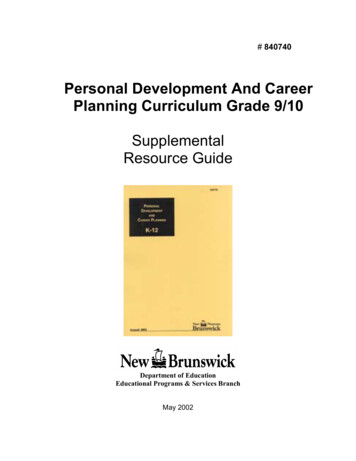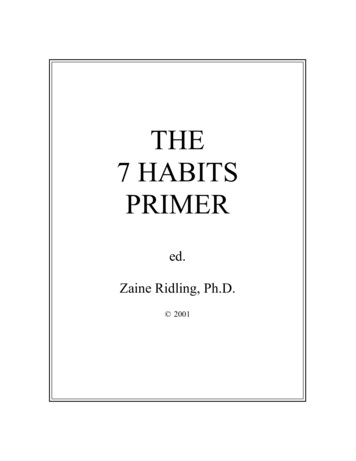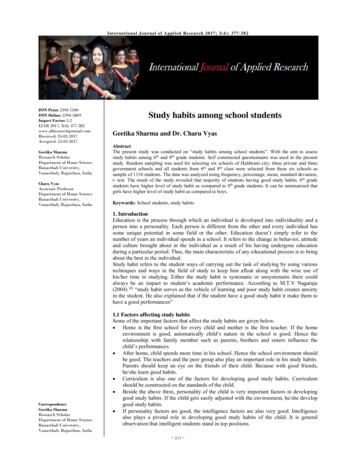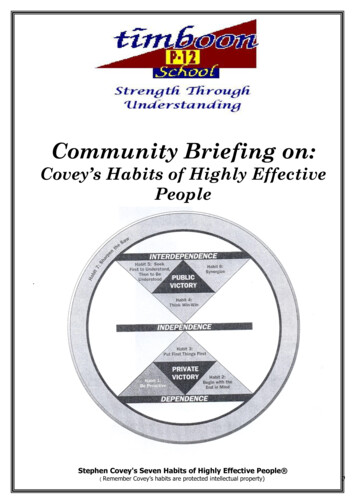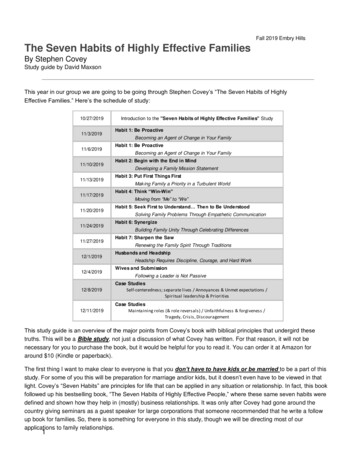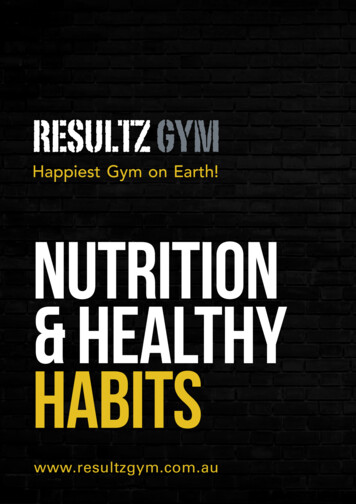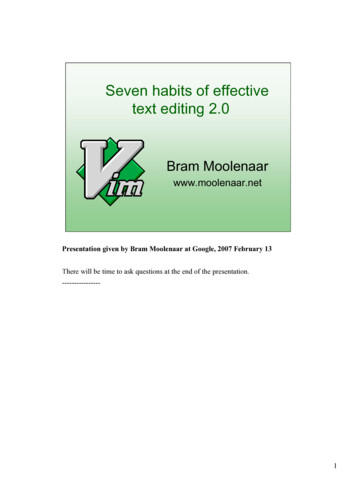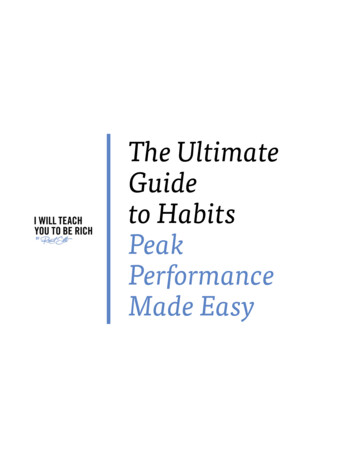
Transcription
The UltimateGuideto HabitsPeakPerformanceMade Easy
IntroductionImagine how it would feel if every time you put your mind tosomething, you got it done. You didn’t start and stop. You nevergot off track. You just finished what you started — no questionsasked. Today, I'll show you how.Do you ever wonder how the most successful people get so muchdone?When they say, “I’m going to.” lose weight, write a book, quitsmoking, etc., you know they’ll actually do it.But when you set the same goals, you’re not so sure. Maybe youwill do it. Maybe not.Each time you try, it's a yo-yo. You start, hit a roadblock, lose motivation, then beat yourself up for not finishing. Over and overand over again.It’s frustrating and discouraging. Worst of all, you're not doing thethings you really want to accomplish.The truth is, you’re more than capable of achieving every goal youset. But if you really want to accomplish the goals you set, youneed a better strategy for getting things done. A proven systemthat helps you stick to — and finish — everything you start.That’s exactly what I have for you in this free guide: a provensystem that’s helped me write a New York Times bestselling book,build a multimillion-dollar business, put on 40 pounds of muscle,and live a Rich Life.
Even more fundamentally, it helped me filter through the millionsof possibilities out there, ignore all the distractions, and get started on my biggest goals in life.Are you ready to achieve any goal you have with less effort?Let’s get started.Why I wrote this guide:Ten years ago, I was a scrawny 127 lbs college student. I thoughtI could never put on muscle because I’m just a skinny Indian. Ispent years wishing I could, without doing a thing about it.You know what changed? I got tired of looking around, watching other people get fit, and feeling left behind. I finally saidENOUGH! and did something about it.I invested in a trainer and made working out a habit. I built a system that virtually guaranteed my success.
Since then, I’ve put on more than 40 lbs of muscle, which feelsamazing. And it’s crazy to think about how far I’ve come.I’ve used these same habit-building techniques to earn more money, grow my business, and live a Rich Life.I stopped dreaming and started accomplishing.Now I want you to experience this radical shift in your life — nomatter how many times you might have struggled to stick to yourgoals in the past.How many times have you said to yourself: I’m going to start working out 5x a weekI’m going to start drinking 8 glasses of water a dayI’m going to eat less processed foodsI’m going to floss every morning and nightAnd how many times have you followed through on those goals?If your answer is “not often enough,” don’t worry. It’s not yourfault. And with the systems, frameworks, and strategies laid out inthis free guide, you can easily change that.You can learn how to make your habits stick for life. Once you
know how to do this, you virtually guarantee success in everything you do — from this moment forward.Who Am I?About Ramit SethiHi, I'm Ramit Sethi, the New YorkTimes bestselling author of I WillTeach You To Be Rich.I've helped millions of readers buildbusinesses, land their dream jobs,become debt free, and master theirinner psychology so they can build aRich Life.In this guide you’ll learn:How to Set Better Goals: 3 Steps to Achieving AnythingMost people don’t know how to set good goals. They just think ofsomething they want and then start “trying” to make it happen.When they don’t, they’re left wondering what went wrong. In Part1, I’ll teach you the best way to set and reach your goals.Get in the Habit LoopHave you ever wondered why it’s so tough to make little changesin your life? And why some people seem to be able to do it withease, while others fail to follow through time after time? In Part 2,I’ll teach you a simple system that makes forming and keepingnew habits effortless.
Do you ever say to yourself, “Why did I lose my motivation?” InPart 3, I teach you why relying on motivation is a loser’s game —and what to do if you ever get off track.How to Create Habits that Stick — ForeverOnce you’ve successfully started a habit, how do you keep it going? In Part 4, I’ll teach you why sometimes, simple systems breakdown and how you can get back on track towards lasting behavioral change.How to Stay Laser-FocusedSometimes the hardest part of accomplishing your goals is beingable to see the big picture and having the wherewithal to stay laser-focused until you’re done. In Part 5, I’ll show you the best tipsfor staying locked in on your Big Wins.Living a Rich LifeAt this point, you’ll have learned from some of the top behavioralexperts on how to succeed faster than you thought possible.You’ll also have learned some of the key strategies you need tocreate lasting behavioral change. In Part 6, I’ll share even more ofmy best material on using behavioral change to live a Rich Life.
Part 1: How to Set Better GoalsWhen it comes to goals, a lot of us experience what I call theTreadmill of Disappointment.Tell me if this sounds familiar 1. We get really motivated to try something new. (“TODAY’S THEDAY!”)2. We clean the house, pay our bills on time, or finally make it toInbox Zero.3. The first day or two goes okay but then we forget to do something on our lists, get distracted, or simply procrastinate.4. Guilt creeps in and we avoid working hard (which only leads tomore guilt and procrastination).5. Until finally, we give up.6. Then the waiting game begins until “motivation” strikes again,starting the whole process over with our newest fascinationand a NEW list of goals.Not the best way to move the needle on what’s most important to
you.The good news?You can get off this treadmill.Let me show you a better way of achieving what you set out to do.A way that sets you up to win without ever giving up.3 Easy Steps to Achieve Anything1. Ride the waveOne of the most important “hacks” I ever learned for achieving mygoals was to “ride the motivational wave.”“Motivational waves” are those moments where we feel reallyinspired to take action on a list of to-dos. Remember the last timeyou cleaned your whole house? That’s a motivational wave.I learned this from one of my mentors, BJ Fogg, who runs Persuasive Technology Lab at Stanford.In this video, Fogg explains how to use these “motivational waves”to your advantage.rather than getting really motivated and fallingback into our old ways of doing things a few days later.Check it out:Click here to watch the videoWhat this might look like in your life:Example 1:
BJ Fogg wanted to drink more tea. So when his motivation wasat its peak, he bought a bunch of tea, an electric kettle to boil water, and set everything up in easy-to-reach places on his kitchencounter. He built a system so that it was a no-brainer to make teawhenever he was in the kitchen.Example 2:A few years ago, I was trying to form a gym habit. The problem Ihad was that I’d get up in the morning planning to go to the gym,but after a few minutes of being awake, I’d decide not to go. So,the next time I was feeling really motivated, I built a system. Itlooked like this: I put my gym clothes and my shoes next to mybed so I saw them first thing in the morning. As soon as I got outof bed, I would get dressed. By the time I finished putting on myclothes, I’d think to myself, “Well, might as well go to the gym” andI DID!These types of systems guarantee success. THAT’S what youshould use your motivation for — to set up fail-proof systems.That way you’ll follow through even when you’re no longer motivated.What you can do right now:The next time you’re feeling “motivated” — either right now orlater this week — use that to your advantage.Make a list of everything you need to get in order to accomplishyour goal.Then, sketch out a rough outline of your fail-proof system that’llhelp you follow through (like the examples above).We’ll go into much more detail of how to set up these systems lat-
er in the guide, but don’t let that motivation go to waste. Captureyour rough ideas whenever your motivation is at a peak.2. Start small, then go big later onWhen you’re starting out with any goal — like exercising — it’sbetter to actually start than to dream about starting forever. Withexercising, that means ACTUALLY walking one mile once perweek is better than PLANNING to run three miles 3x per week.and never running at all.Each mile you walk represents a “little win” for your goal.And getting a lot of those little wins is what helps you succeed. Because with each little milestone you achieve, you’re actually doingwhat you set out to do.not just hoping things work out.Here’s how to use “little wins” for your goals: Instead of planning to do 100 pushups per day to get back inshape, just do two pushups a day to get started. Instead of thinking you have to floss all your teeth, just focuson one tooth a day to get things going. Instead of trying to drink a gallon of water a day instead ofsoda, just drink one glass of water before you go to bed. Instead of starting a million-dollar business from scratch, justfocus on getting your first paying client.You can ramp up from there. But you don’t want to fail from thestart.What you can do right now:Think of some of the goals you’d like to accomplish (getting fit,learning a new language, cleaning your house). Then break those
down into the TINIEST steps you can imagine. And I mean SERIOUSLY tiny: 2 pushups per day, 1 tooth, 1 glass of water however small you need. Make it something you KNOW you can do.Draft up a plan for how you’ll do this for 2 weeks. Once you hitthis target, then you can consider expanding.But remember, big goals are accomplished with tiny steps. Howcan you start taking some of those tiny steps today?3. Put it on your calendarImagine you’re playing in a basketball game against LeBron James.You have the best shoes, the most expensive pair of athletic shorts,a fancy headband, and the greatest jersey in the world. And he hasno shoes, ripped shorts, and a dress shirt.Who would win?LeBron, duh.It sounds ridiculous, right? But we play this same game againstmotivation every day.The tools don’t matter as much as we think.Novices LOVE to focus on productivity hacks, apps, and tools. It’seasy — and frankly, more fun — to play with new shiny tools thanto simply do what works.But usually, the fundamentals — things like a simple calendar, pen,and paper — work just as well if not better than some app.Take a look at my calendar system.
See how it’s not a super advanced set of apps? I purposely make iteasy on myself so I can follow through and easily update it.EXECUTION is more important than the tactic itself.What you can do right now: Decide ahead of time and map out your schedule for the weekeither on paper or in a simple calendar system. Put your baby steps goals into your calendar system. Then, set an alert in your calendar or on your phone to reviewthis every week.If you keep thinking ahead, you’ll never be caught off-guard orpressed for time. Those tiny improvements every week will addup. And it won’t be long before you’re crushing every goal youset.Learning how to set goals like this increases your chances ofmaking your habits stick.
Part 2: Get in the Habit LoopWouldn’t it be great if you never had to worry about hitting yourgoals? You could just do what you were supposed to do withouteven thinking about it.Sounds like a pipedream, right?But it’s possible, IF you know how habits work.When you do, you can take full advantage of them and put yoursuccess on autopilot.How To Use Habits To Your AdvantageAccording to Charles Duhigg, author of The Power of Habit, everyhabit has three components:
A cue, which is a trigger for a behavior to start (like your alarmclock going off) A routine, which is the behavior itself (like getting out of bed) A reward, which is the benefit of taking that course of action(like a nice, warm cup of coffee waiting for you when you getout of bed)The reward is how your brain actually learns to want a particularbehavior in the future.You put 2-and-2 together and equate the pleasure of drinking acup of coffee with getting out of bed.This is how people pick up bad habits, like smoking, but it’s alsohow people stick to good habits like exercising. They link a cueand routine to a reward.For decades, people focused exclusively on changing the behavior:the routine itself.But now, we know that cues and rewards are actually the mostimportant parts of making a habit stick. If you get the cues andrewards right, the routine forms by default.So choosing your reward — not the routine — is actually the mostimportant step.Reward yourself MORE to create lasting changeEating chocolate can help you exercise more. Yes, you read thatright: Research has shown that eating more chocolate can help youstick to an exercise regimen.Here’s why: Eating chocolate at the end of a workout is a simple
way to ignite the reward centers in your brain. It cements thegood feelings that make a habit take root.It sounds contradictory (that eating chocolate and exercising gotogether), but it’s true. Why do you think a lot of really fit peopledrink smoothies or protein shakes when they finish working out?It’s the same principle at work. The sweet drink acts as a rewardfor the behavior. Plus, it’s a little better for you than the chocolate.I recently sat down with Duhigg to talk about how to create newhabits.And in this part of our chat, he explains how important rewardsare. The best part is you can choose your own rewards and easilymake new habits stick.Click here to watch the videoThe key takeaway? Always reward yourself. You don’t want to endyour workout, leave in a rush and not be able to reward yourselfwith a smoothie or a relaxing shower. Make sure you can giveyourself a reward to make sure the behavior sticks.Here are some sample rewards you might use: Give yourself 5-minute breaks for every 20 minutes of deepwork you do Allow yourself to buy a nice pair of shoes after you hit yoursavings goal for a month Watch a TV show (guilt-free) after cooking a healthy mealThe reward can be anything you choose, as long as you’re givingyourself something you genuinely enjoy.
Choosing your new routine (why “quitting” doesn’t work)It’s very hard to simply stop a bad habit. That’s because you’realways getting whatever cue was telling you to do the bad habit inthe first place.So what can you do about it?You’re much more likely to be successful if you change a bad habitinto a better behavior.Here’s a common example: A lot of us crave something sweet toeat right after lunch. We hit the vending machine for chocolates,cookies, or some other sweet to get our fix.Because yes, sweets and desserts taste good, but a habit is muchmore complicated than that. Maybe getting that sweet gives you a burst of energy from thesugar so you can push through the rest of the day. Or maybe you’re not ready to go back to work so getting up fora snack gives you a chance to walk around the office and chat.It’s not just the sweet that’s creating your behavior. There’s awhole series of reasons that surround it.Instead of just giving up the sweets, maybe you could try gettingup from your desk and eating an apple instead. Or maybe, if it’sthe energy from the sugar that you’re craving, a cup of coffee willdo the trick.The important thing to note is that you’re not stopping cold turkey. Instead, you’re replacing a “bad habit” with a new, better one.Over time, this will become your new routine. And doing it will
kick in automatically after the cue.Here are some ideas for simple replacements you can try: If you’re drinking too much coffee, drink decaffeinated teainstead. If you overeat when you’re feeling stressed, chew gum afteryou’ve eaten your regular portion of food. If you always hit the snooze button on your alarm clock in themorning, move your alarm to the other side of the room so youhave to get out of bed to hit snooze.Replacing bad habits can dramatically change your life. Not onlydo you stop doing the bad thing, but you pick up a better habit inits place.If you only do this, you’ll be 100x ahead of other people who can’tfigure out why they never finish things.But there’s another way to exponentially improve your life: do themost important habits first.The Most Powerful HabitsSome habits are much more powerful than others.Take exercise. For a lot of people, once exercise becomes a habit,they tend to start eating better and making sure they get enoughsleep.That makes sense, right? You don’t want to come in from yourmorning run and grab a bagel and cream cheese. You’re exercisingto feel better, so it’s only natural that you’ll want the food you putin your body to help you feel better, too.
I also learned a very interesting fact: Once you start exercisinghabitually, you also start using your credit card less, doing yourdishes earlier in the day, and procrastinating less at work.It’s not like you’re making a conscious decision about this. Instead,for a lot of people, exercise is a keystone habit.When they do it regularly, it starts to change their self-image. Andwhen that changes, they start thinking of themselves as the type ofperson who wakes up and exercises every morning. And the typeof person who doesn’t pull out their credit card, gets chores done,and doesn’t procrastinate at work.Think about it. How many CrossFitters in your office do youknow who regularly goof off or procrastinate at work?Nailing down that first habit might feel nearly impossible if you’vefailed to make it happen in the past. But if you use the strategiesI’ve shared so far, not only will you be able to create lasting behavioral change, but you’re also likely to build a lot of other habitsautomatically.
Part 3: How to Get Back on TrackEven the best-laid plans sometimes fail. That’s life, and you haveto be prepared for it.But these setbacks don’t have to knock you off-course permanently. Often, you can get back on track with some very simple fixes.Here’s how to KEEP a habit going once you’ve created it (in lessthan 3 minutes).Click here to watch the videoSetting up safeguards like this helps you get things done evenwhen you don’t feel like it. But let’s be honest, failing sucks. Evenif we plan for it, it’s tough to deal with the feelings and emotionswhen we actually experience it.There is a way to overcome those feelings and use failure to getahead.How to use failure and setbacks to your advantageWhen I was applying to colleges, I noticed something interesting.
A lot of the people I knew were applying to top schools, and ifthey were rejected they’d say, “Whatever, I didn’t want to go thereanyway.”What!?I remember thinking, “If you didn’t want to go, why’d you apply?And if you DID want to go, why give up so easily?”I fully expected to get rejected from my dream school (Stanford).That’s why I outlined a plan of specific actions I’d take to get ineven after they rejected me. I was going to send them updates onmy coursework, my copywriting business, and press clippings ofarticles I wrote.Getting a “no” was only the first step of the process.That’s how it is in other areas of life as well. From selling to datingto business — to just about anything. We need to expect failureand plan what we’ll do when rejection comes.Every top performer does this.James Altucher, author of Choose Yourself, talked about this process when we discussed how to deal with failure.Click here to watch the videoWe all worry about failing on some level. But it’s how you managethe fear of failure that determines your success.Success, though, is a tricky subject.Sometimes when we push through our fears and overcome chal-
lenges, we easily get what we want. Other times, it seems likethings will never pan out. How do you know the difference? Andhow do you know when you should push through obstacles andwhen you should give yourself a break?Should you stick to it or change course?Maybe the habit you’re working on is running every day. Youwant to get ready for a marathon at the end of the year. You aren’trunning 100 miles a week yet, but you’ve been consistently running a mile a day for the past month.Then one day you wake up, and you’re not feeling it. You put yourclothes on, but you’re not in the mood. You grab your headphones,open the front door, even take your first step, and you still don’twant to do it.How do you decide whether to push through or go back to bed?Whether it has to do with building a running habit or any othergoal that you’ve already deemed worthy of your pursuit?Asking the following questions might help you out.When to Push Is this goal aligned with what I really want? Will not doing this activity today jeopardize my chances ofreaching my goal in the time specified? If I don’t do this activity right now/today, will I regret it? Will not doing this activity today impact someone I care aboutin a negative way?If you answered yes to any of these questions, you might want topush ahead.
When to Rest Am I feeling drained, depleted and depressed? Has my rigidity or commitment to doing this activity every daygotten in the way of my primary relationships? Can I take one day off without affecting my ability to accomplish my goal in the time specified? Is participating in this activity allowing me to ignore other difficult or challenging issues in my life that need my attention?If you answered yes to any of these questions, you might want toback off and give yourself a day to regroup.
Part 4: How To Make Any Behavior Stick– ForeverHave you ever said you were going on a diet?Maybe you stuck to it for a few days. Then, one day, you find awhole chocolate cake in your fridge. You say, “I’ll just have onepiece.” And then, 3 days later, all that’s left is an empty plate, a fewcrumbs, and a lot of guilt.Why does this happen? Why does it seem so hard to make goodhabits stick — even when you’re really committed?Jerry Seinfeld knew why, and he also knew the secret of lastingchange: building momentum. Check out this story that explainshow Jerry is able to stay so productive and prolific throughout hiscareer. This is how he stays on track to meet all of his goals evenwhen he faces tough challenges:He told me to get a big wall calendar that has a whole year on onepage and hang it on a prominent wall. The next step was to get a bigred magic marker.
He said for each day that I do my task of writing, I get to put a bigred X over that day. “After a few days you’ll have a chain. Just keepat it and the chain will grow longer every day.You’ll like seeing that chain, especially when you get a few weeksunder your belt. Your only job next is to not break the chain.”“Don’t break the chain,” he said again for emphasis.I love Jerry’s “Don’t Break the Chain” calendar. It’s not just aboutdoing something each and every day.It’s about the cumulative effects of all of your habits.For example, maybe you had an extra busy week at work, and youdidn’t get to the gym for 5 days in a row.You’ll look at that week on your calendar and see that you have no
red Xs on it. However, when you expand your view, your calendarlooks like a blood bath.That’s what really counts.You just have to make sure that when you do get back to your regular routine, that 5 days off doesn’t turn into 5 months.How do you do that?You go back to your plan.It might be that your cue is no longer working or that your rewardis no longer doing its job.This can happen if your life follows a different pattern for a fewdays, like it might when you’re out of town for a conference.The way to get back on track with your habit is to revisit yourhabit loop, make sure your triggers are in place, that you’re stillcommitted to the routine, and that your rewards are clear andpleasurable for you.Setting up systems is the best way to keep yourself going. And toget the most from our efforts, we have to find the best system forus and then adjust if it’s not working.
Part 5: How to Stay Laser-FocusedA couple of years ago, one of my friends asked me, “What’s yournumber one goal?”That question made me nervous. I didn’t want to answer. I wasafraid that if I said my single most important goal, I’d be closingdoors to all of my other goals. Of which there were many.I said this: “I want to be a bestselling author, but I also want togenerate revenue, and I want to do this and publicity and blah,blah, blah.” He cut me off and said, “Cut the BS. What’s your number one goal?”Again, I hedged. But he pushed me and forced me to get crisp. Hesaid, “The number one goal.”I said, “I want this book to be a New York Times bestseller.”We hate giving ourselves constraints because it feels limiting. Itseems like we’re giving something up, and that’s exactly what itfelt like in that moment.However, it’s also freeing at the same time.
Once I decided (declared out loud) that I wanted to become aNew York Times bestselling author, I eliminated about 70% of mymarketing plan and it became crystal clear what I needed to do inorder to achieve my goal. I focused all of my attention on thosethings.Once my book became a bestseller, then I could do a lot of theother things that I wanted to do.This was a classic case of moving up gradually, but of course, likewe talked about in Part 2, our natural inclinations are to go big.What we need to do is to get crisp. Crisp about what exactly it iswe want.The dating world is another example.Let’s say you’re single and you’ve had a few boyfriends or girlfriends. You meet someone and they ask you, “Hey, what kind ofpeople are you into? I know a lot of people, maybe I can set youup. What kind of person are you looking for?”Most people would be super generic about that answer. “Oh, well,I like girls who are smart and nice.” A girl might say, “Oh, I likeguys who are nice, maybe a little taller than me, and older.”That’s super generic — and a super generic answer will get you asuper generic date.In reality, you know exactly what kind of person you want. If youwere being honest you’d say, “I am looking for an Asian girl who’s5’5”, between 25-33 years old, has a beyond entry-level job at a big
tech company, has lived in other countries, and is into endurancesports.”But nobody wants to say that because they’re afraid to limit themselves. We worry about closing the doors on other opportunities,but it’s like we’re worried about not getting 100%, when if wedon’t choose, we won’t even get 1%.If you want something big, it’s critical to make that initial choiceto commit to a tangible and specific outcome.The good news is that once you do that, you apply that winningprinciple to the next item.Here’s an excerpt from an interview I did with my longtime friendNoah Kagan. He’s the one who called me to the mat.Noah is a master at helping people (and himself) get laser-focusedon their goals. Pay special attention at 3:53 where he talks aboutthe strategy that has made him the most successful, financially andotherwise.Click here to watch the video.How to achieve your biggest goal in under 1 yearNow, I want to challenge you to do what Noah said.Pick the biggest goal that you want to accomplish in one year.Maybe it’s to get 10,000 people on your list, run a marathon, finishyour first Ironman, do 5 dead hang pull-ups, or lose 20 pounds.Whatever it is for you, declare it. And then mark your calendar forone year from today.Next, break it down on a monthly and daily basis. By doing this,your big, hairy, audacious goals become manageable and by having daily accountability built in, you can use it as a filter for all of
your decisions.I work with a lot of people who want to start an online business.It’s a very exciting time for them — but it’s also challenging toknow what to focus on, who to listen to, and what bright andshiny objects are worth their time.So I ask them, “What’s your number one goal?” If they say, “I wantto get 5,000 people on my list in one year,” then we have something very concrete to work with.When they come to the group and say, “I was doing such and suchon Twitter the other day,” the group will immediately call themout and say, “Is Twitter going to help you get to 5,000 people onyour email list?”In 95% of the cases, the answer is no. It might be more fun thandoing what it takes to get to 5,000, but it’s not going to get themthere.Having that kind of focus is what has enabled me to grow mybusiness from nothing 11 years ago to now being a multimillion-dollar business with 30,000 students all over the world.Limiting your options may seem scary, but if you do it, yourchances of accomplishing your goal increase exponentially.So, get laser focused on what you want and then be willing to leteverything else take a back seat. If you get it right, you can bringthem back to the front when the time is right.
Part 6: Living a Rich LifeAt this point, you’ve learned some of the key systems and strategies you need to create lasting change in your life.You’ve also heard from some of the top behavioral change expertsout there.Now, I want you to use your new goal setting skills to live an evenRicher Life.Where will your new habits help you next?Become a Finisher“I'm ready to follow through on every goal I set.”Show me how I can!Meet Top Performers“I'm ready for more! I want a network of top performers to holdme accountable and expert guidance on how to hit my biggestgoals.”Tell Me More
Start a Business“I want to use my new skills for developing habits to start my ownbusiness.”Tell Me More
All rights reserved, I Will Teach You To Be Rich, Inc.
Instead of starting a million-dollar business from scratch, just focus on getting your rst paying client. You can ramp up from there. But you don’t want to fail from the start. What you can do right now: Think of some of the goals you’d like to accomplish (getting t, learni


